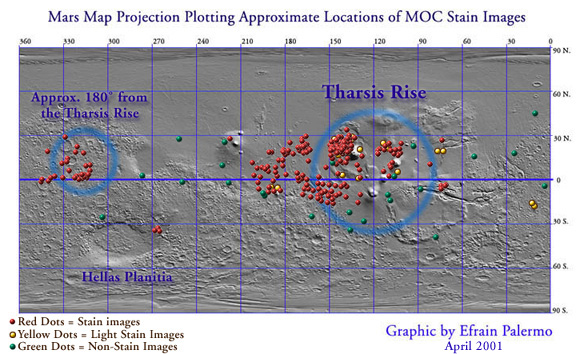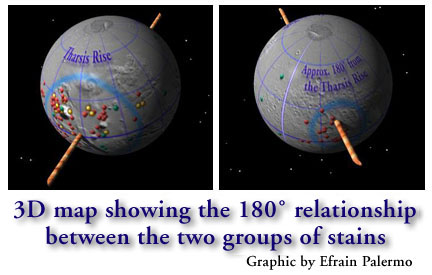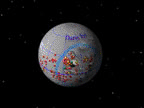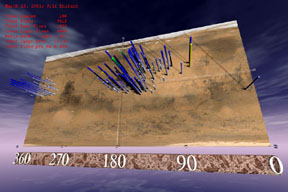Palermo's Martian Anomalies • A Study of MOC Stain Images

This is a roughly plotted map to show the locations of MOC images which I have found (over 400 so far) which contain stains. The red dots represent stains that are the darkest (or freshest) and the yellow dots represent grayer (or older) stains. (Green dots are non-stain images in the equator This is being done to see if there is any geographical correlation between the stain locations and/or any relationship between the darker and lighter stains.)
(Each dot is a MOC image panel, some may contain up to a hundred stains)
Some interesting patterns are showing up! Approx. 95% of the stains falls below 30 degrees N. and above 30 degrees south of the equator, within the warmer equatorial zone.
Note: A clickable map was not workable on this page but if you want to click and go to a MOC stain image on this map go here


Click here to see a Quicktime movie of rotating flow plots.
Note: These maps are for illustration purposes and are not exact.

NASA is talking more and more about water on Mars. A recent announcement (see below) indicates that the Tharsis Rise was built up with water laden lava. The Tharsis Rise was caused by the reaction to a huge impact on the other side (180ž) of Mars. The Hellas Basin (Hellas Planitia) is the impact crater left over by that collision.
Notice the cluster of stains on and around the Tharsis Rise and also at approx. 180ž away, north of the Hellas Basin. Dark stains are in the area where water is now thought to have existed in the past, and they are also exclusively in the equatorial belt.
ANY images that would show that these stains are being created in present time would be a very strong argument that these stains are being caused by WATER.
Next, I'd be expecting NASA to state that these dark "dust" stains are indeed water stains.
"Secrets to Mars Water Hidden in Volcanic Remains. By Robert Roy Britt space.com 15 March 2001
Scientists have become increasingly convinced in recent years that Mars, which now appears mostly dry on the surface, was once warm and wet -- the sort of place where life might have got a toehold and possibly even flourished. But looming questions have formed around this expectation: Where did the water come from, and for how long was the Red Planet wet? A new study points a finger at one of the most obvious features on Mars, a hulking, elevated region known as the Tharsis rise that may have released tremendous amounts of lava, along with water and carbon dioxide that combined to possibly create a habitable planet. The research also narrows the range of time, under this scenario, that Mars would have been wet. Reporting in the March 15 issue of the journal Science, a group of 11 scientists used computer models to analyze gravity and topography data from the Mars Global Surveyor, which is currently orbiting Mars. The results suggest that the volcanic activity, thought to have occurred more than 3.5 billion years ago, left certain prominent features of the Martian landscape still visible today. Full story here: http://www.space.com/scienceastronomy/solarsystem/mars_landscape_010315.html "
Go to the next
page for a further analysis. ![]()
Acknowledgments:
There are many people who have also seen these stains and thought there was more to them and have either compiled some stains or posted something on their site. I want to acknowledge those who have worked on this subject and I welcome any links or contributions to this site!
The following people have forwarded to me stain images which I have posted:
Jill England
Mark Thompson
Chris Whitehead
Mike Sweeney
Gianluca Napolitano of Florence, Italy
John Levasseur
Locations vs. Number of dark flows on Mars.
Lines are scaled logarithmically to the number of dark flows found in each image. The height of each line is white(0) , blue(.75*max), green(max). Maximum on this image is 5.215 which corresponds to the 184 dark flows in the "Valley of Stains". Yellow lines are areas of light stains with no dark ones present. Orange lines are of images I've not counted yet. In 166 images showing flows, 1823 dark flows have been counted and 3989 light flows have been counted, total flows = 5812. There are still 19 flow images to be counted. The lines overlap, no attempt has been made to resolve the overlaps, through averaging. No attempt has been made to scale the number of flows relative to the area of each MOC image.
3D chart by Jill England.